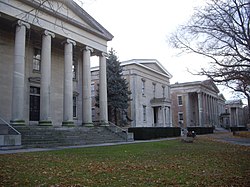Sailors' Snug Harbor | |
New York City Landmark No. 0022–0027, 0742–0743, 1204–1205
| |
 "Temple Row" | |
 | |
| Location | 914–1000 Richmond Terrace, Staten Island, New York City, New York[1] |
|---|---|
| Coordinates | 40°38′33″N 74°6′10″W / 40.64250°N 74.10278°W |
| Built | 1831–1833 |
| Architect | Martin E. Thompson; Minard Lafever |
| Architectural style | Greek Revival, Late Victorian |
| NRHP reference No. | 72000909 |
| NYCL No. | 0022–0027, 0742–0743, 1204–1205 |
| Significant dates | |
| Added to NRHP | March 16, 1972[2] |
| Designated NHLD | December 8, 1976[3] |
| Designated NYCL | October 14, 1965 (landmarks 0022–0027: buildings A–E and chapel) May 15, 1973 (landmarks 0742–0743: iron fence and gatehouse) October 12, 1982 (landmarks 1204–1205: interiors of building C and chapel) |
Sailors' Snug Harbor, also known as Sailors Snug Harbor and informally as Snug Harbor, is a collection of architecturally significant 19th-century buildings on Staten Island, New York City. The buildings are set in an 83-acre (34 ha) park along the Kill Van Kull in New Brighton, on the North Shore of Staten Island.[4] Some of the buildings and the grounds are used by arts organizations under the umbrella of the Snug Harbor Cultural Center and Botanical Garden.
Sailors' Snug Harbor was founded as a retirement home for sailors after Captain Robert Richard Randall bequeathed funds for that purpose upon his 1801 death. Snug Harbor opened in 1833 as a sailors' retirement home located within what is now Building C, and additional structures were built on the grounds in later years. The buildings became a cultural center after the sailors' home moved away in 1976. The grounds and buildings are operated by Snug Harbor Cultural Center and Botanical Garden, a nonprofit, Smithsonian-affiliated organization.
Sailors' Snug Harbor includes 26 Greek Revival, Beaux Arts, Italianate and Victorian style buildings. Among those are "Temple Row", five interlocking Greek Revival buildings labeled A through E. The buildings are set in extensive, landscaped grounds, surrounded by the 19th-century cast-iron fence. The grounds also include a chapel and a sailors' cemetery. The cultural center includes the Staten Island Botanical Garden, the Staten Island Children's Museum, the Staten Island Museum, the Newhouse Center for Contemporary Art, and the Noble Maritime Collection, as well as the Art Lab and the Music Hall.
The site is considered Staten Island's "crown jewel"[5] and "an incomparable remnant of New York's 19th-century seafaring past."[6] It is a National Historic Landmark District. Several buildings in the complex are New York City designated landmarks.
- ^ Cite error: The named reference
guide2nycwas invoked but never defined (see the help page). - ^ "National Register Information System". National Register of Historic Places. National Park Service. April 15, 2008.
- ^ "Sailors' Snug Harbor". National Historic Landmark summary listing. National Park Service. September 11, 2007. Archived from the original on June 6, 2011.
- ^ "About Us". Snug Harbor Cultural Center & Botanical Garden. Archived from the original on April 2, 2015. Retrieved March 31, 2015.
- ^ Seth Kugel (November 11, 2007). "Staten Island: Getting Beyond the Ferry". New York Times. Archived from the original on April 2, 2015. Retrieved July 16, 2008.
The Snug Harbor Cultural Center is its crown jewel. Originally an 18th-century home for "aged, decrepit and worn-out sailors," it now houses the Newhouse Center for Contemporary Art, the Staten Island Children's Museum and the Staten Island Botanical Garden, where November is orchid and chrysanthemum month, and every month is New York Chinese Scholars Garden month.
- ^ Dunlap, David W. (March 23, 1987). "Dispute Grows on Ex-Sailors' Home". The New York Times. ISSN 0362-4331. Archived from the original on November 9, 2017. Retrieved August 13, 2020.